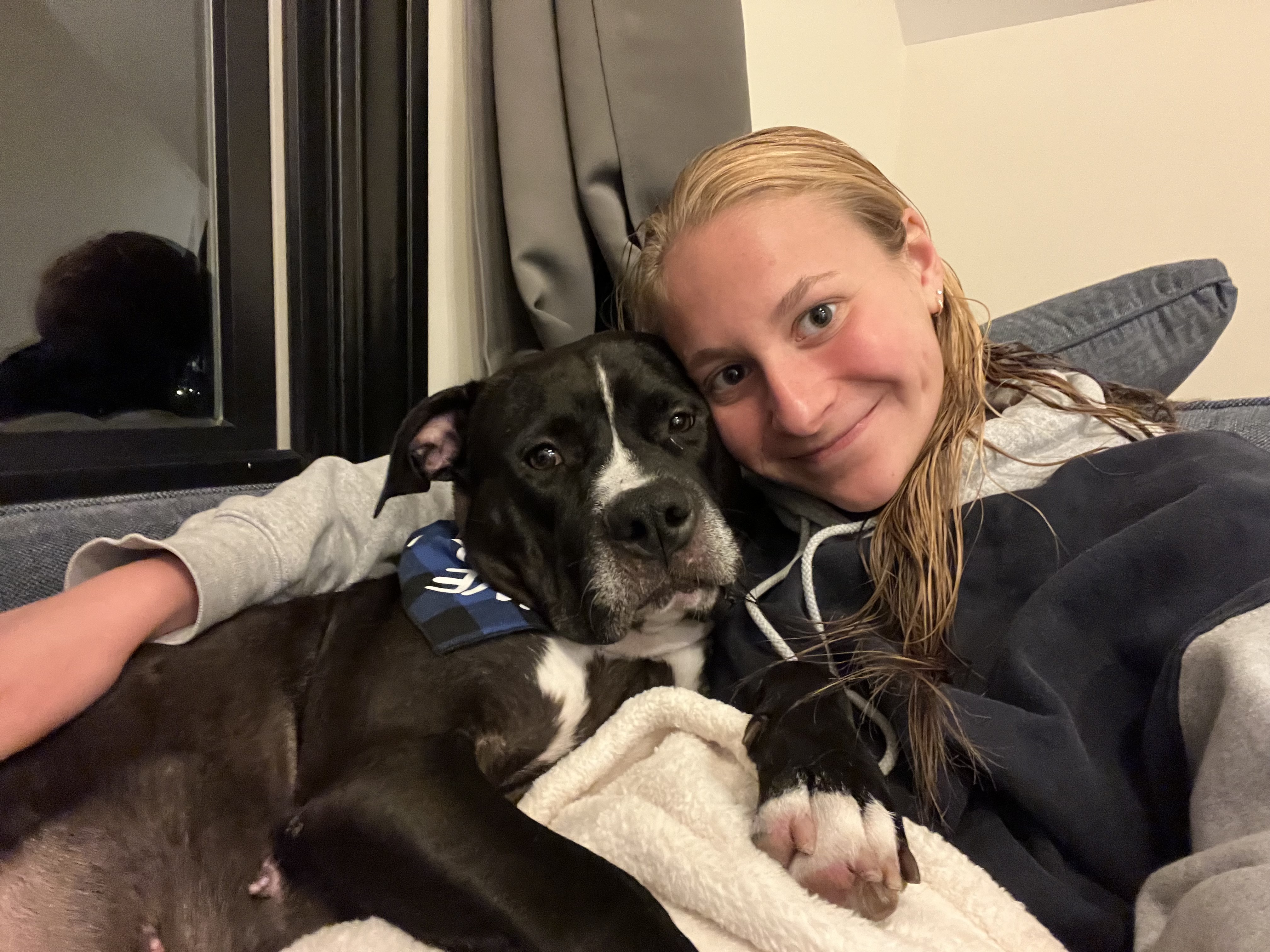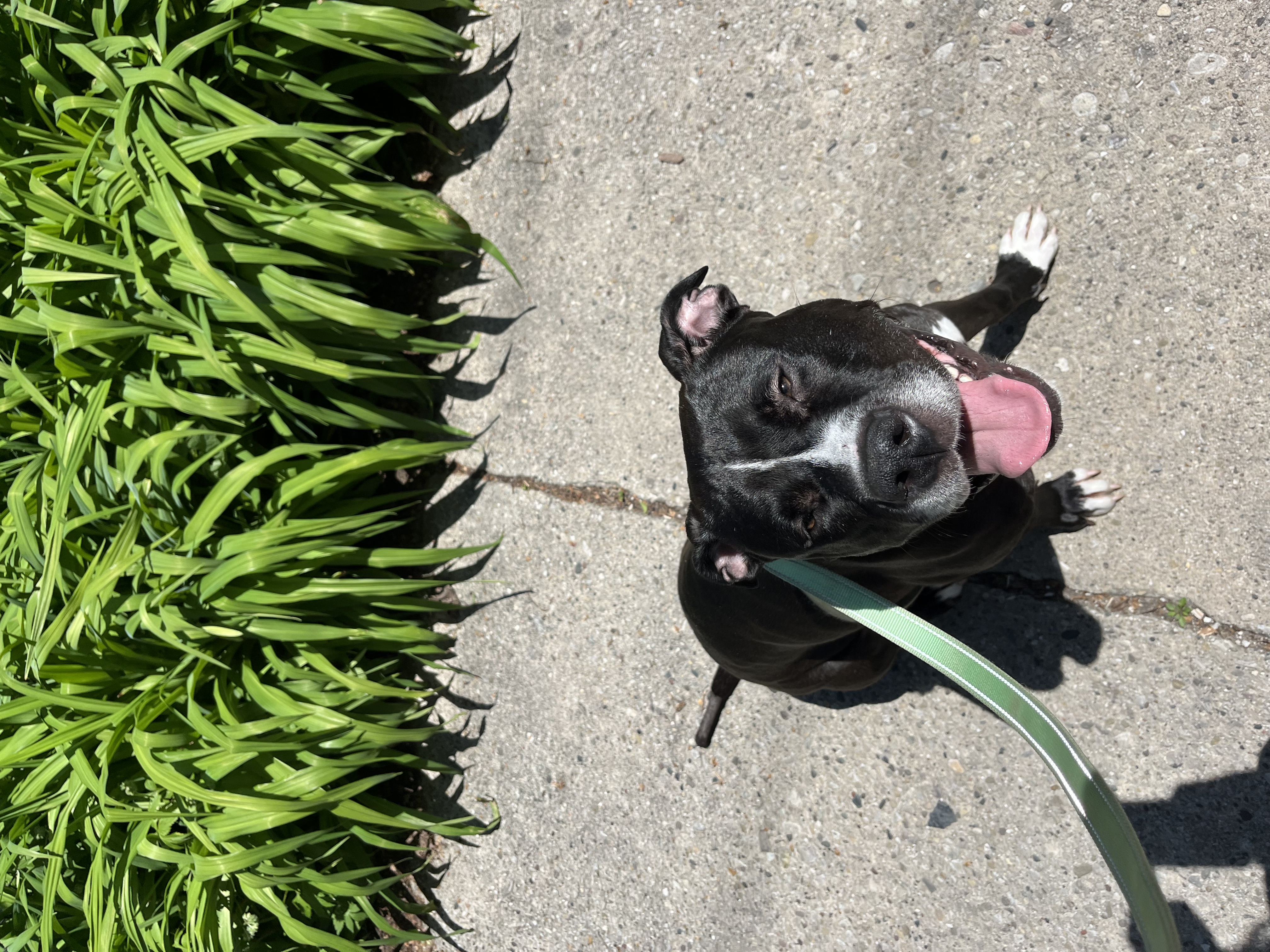A growing number of students are turning to animals to lessen their anxiety. They say that despite the cost, time commitment and arguments with their landlords and roommates, the company of a furry friend tends to be worth the effort.
Every time her rabbit does a backflip through Kim Sloan’s living room, her anxiety eases.
“She makes my day better just by being around,” she said. “I appreciate the companionship.”
In her second year at Northwestern, SESP graduate Sloan (’21), decided she needed to address her anxiety and loneliness after moving several states away for college. She talked with her therapist about getting an emotional support animal (ESA).
“Humans really thrive when we know someone’s depending on us,” Sloan said. “I felt kind of disconnected from where I'd come from, but also disconnected from where I was then.”
Then, six years ago, Sloan found Peach. While surfing through a Facebook page, she found a Netherland dwarf rabbit with orange-red fur for sale. She knew wanted an animal because she’d grown up around pets, but she didn’t want a bigger animal, such as a cat or a dog. Sloan was staying in Chapin Residential College at the time, and she said she could have been influenced by the fact that its mascot is a rabbit. She picked up Peach a couple of days later from Indiana, and they have lived together ever since.
Sloan said owning Peach has made it “a little easier” to practice self-care. For example, Peach needs lettuce, so Sloan had to remember to go to the dining hall. She said Peach has been with her through so many important times in her life, which only deepened their connection.
As college students prepare to move into their dorms for the upcoming year, they’ll be packing some key items: clothes, toiletries, electronics, and… a Netherland dwarf rabbit?
Toy plushies and blankies can no longer cure the anxieties of students as they navigate a new environment with many social, academic and emotional challenges.
Studies show Sloan’s experience is common.
A study from EdSights, a company that uses data provided by AI text interactions with college students to identify challenges they are facing at college, found that 56.4% of students reported feeling some kind of homesickness, according to an article from Inside Higher Ed. Additionally, the 2022-2023 Healthy Minds Survey found that 41% of the 96,000 college student respondents experienced symptoms of moderate or severe depression and 36% reported experiencing an anxiety disorder.
But there are solutions to this issue. A 2019 study in the Multidisciplinary Digital Publishing Institute found interacting with a dog improved students’ emotional well-being. The study used 82 students from the University of Warwick in Coventry, England and split them into two groups. Individuals in one group spent 10 minutes in a room with a golden retriever, while individuals in the other group watched a video featuring golden retrievers. Immediately following the interaction, students in both groups reported feeling an increase in their happiness and a decrease in anxiety. Participants in the group that interacted with the dog reported a greater decrease in anxiety.
School of Communications third-year Wylde Laden struggled with anxiety at the start of her second year at Northwestern. Her roommate suggested an ESA.
After her parents confirmed that she was calmer around animals, Laden said her therapist wrote her a letter of recommendation for the university. Then, she filled out multiple forms for Northwestern.
Laden adopted a rescued tortoiseshell calico domestic shorthair cat named Delilah Rose Kensington from a woman in Chicago. Laden said her black, white and orange furball is family.

“It’s easy to get bogged down in the minutia of university, the classes and clubs and such,” Laden said. “I find that cats, in general, are a great reminder that it's a structure that we as people have invented. There’s peace, joy, happiness and fun to be had, even in cooped up and hard situations.”
But most animals owned by students are just pets, and not registered service animals.
McCormick fourth-year Ashley Tumpowsky sings to her foster dog Ebony every morning.
Tumpowsky met her pitbull mix with jet-black and white-dotted fur while working a shift at the Evanston Animal Shelter, where she has been volunteering for almost two years. The dog had been picked up off the street.
“I came in one day, and Ebony had just gotten surgeries,” Tumpowsky said. “She had not only just gotten her spay, but she also had to get her tail docked. She had a skin infection and a double ear infection. She had her little cone of shame, and it just tugged at my heartstrings.”
After a couple of months of caring for Ebony at the shelter, Tumpowsky decided to foster her. But because she lived in an off-campus house with 11 other Northwestern students, she first needed to discuss the choice with them and her landlord.
Although Tumpowsky said her landlord had difficulties with pets in the past, she declared herself liable for any damage caused by the dog, and eventually, he accommodated Ebony.

Although the pitbull mix looks scary, he’s her best friend, and she hasn’t passed a lonely day since welcoming him into her life.
“Being at college, I missed my dog at home so much, and that’s why I had originally started volunteering at the shelter,” she said. “No matter what was going on in your day, you come home, and there’s this dog that is so freaking excited to see you. I learned more about the bias against shelter dogs and not judging a book by its cover.”
The Evanston Animal Shelter, where Tumpowsky met Ebony, is a rehabilitation, foster and adoption center for dogs and cats. It often places animals in student foster homes, shelter executive director Vicky Pasenko, 58, said.
“People come to school, and they miss their pets at home,” she said. “Fostering a cat or a dog is a wonderful way to have that companionship in your life.”
Pasenko said the shelter does extensive work to ensure the student will provide a loving home for the pets. Instability can put unnecessary stress on the rescue animals, she said.
Tumpowsky encouraged college students to foster or adopt from the shelter.
“It's just really hard to get dogs adopted these days,” she said. “Moving forward, I will never buy a dog. Go to your local shelter, see what animals they have, make sure it's a good fit. There’s so many sweet dogs, just like Ebony, that are waiting to find their homes.”

Decades ago, college campuses were not buzzing, barking and meowing with student pets or service animals, so how did this come to be?
There has been an increase in requests for emotional support animals on college campuses across the nation, said AccessibleNU associate director Dr. Debra Miller. AccessibleNU's website states is responsible for the "academic accommodation, determination and coordination process for students with disabilities." It approved 11 students to get an ESA in the 2023-2024 school year and has already received over a dozen requests for the 2024-2025 school year. Miller said they will likely receive more.
Meredyth Goodwin, the director of Washington State University’s Access Center, only received two or three requests for ESAs in 2011. But in 2019, Goodwin said the center gets 60 to 75 requests a year, Inside Higher Ed reported.
Because more students are looking for ways to cope with their anxiety, some universities are making it easier for them to take animals into their dorms.
Only assistance animals and service animals are allowed in Northwestern dorms, according to the Service, Assistance, and Other Animals at Northwestern policy. The difference between service animals and ESAs is that service animals are trained to perform a task and can be allowed in public places, while ESAs provide a sense of comfort and safety to psychiatric or emotional conditions, wrote legal book and software publishing company Nolo.
Students can apply to have a service animal or ESA through the AccessibleNU website, where they need to upload letters of recommendation and fill out paperwork that declares them responsible for any damage done by their animals.
However, in off-campus housing, few restrictions exist for ESAs and service animals. Under the federal Fair Housing Act, housing facilities must allow service animals and ESAs if the person has a disability and a disability-related need for an animal. The U.S. Department of Housing and Urban Development said “no pet” policies, pet deposits and higher rents don’t apply to renters with ESAs or service animals. Creatures that provide emotional support can be any type, but under Illinois law, service animals can only be dogs and miniature horses.
Although Ebony was not an emotional support dog, Tumpowsky said the university did not get involved in her decision to foster. Instead, she had to be transparent with her fellow house renters and her landlord. In accordance with their agreement made before acquiring Ebony, Tumpowsky will have to bring the pooch back to the shelter because there are students moving into the house who don’t like dogs.
Sloan said that she does not have to pay an extra fee to rent an apartment because her rabbit Peach is an ESA. But, she said she can understand the occasional unruliness of pets.
“When I moved back into my parents' house after college, Peach ate a lot of drywall – she destroyed a wall before,” Sloan said. “I’ll admit it. More commonly, she gets cell phone chargers. She just bites them right in half.”
Owning pets on and off campus comes with challenges. Sloan recalled her former roommate being annoyed at how much noise the rabbit made during the night. She eventually resolved this by gifting her roommate a pair of “high-tech and expensive” earbuds.
“If you get an emotional support animal, your roommate should really be someone who loves animals and is excited to have them there,” she said. “I know that it probably caused more stress than she wanted at the time.”
Routine pet responsibilities can also be difficult to perform as a college student. Tumpowsky said it’s sometimes hard to walk and give attention to Ebony if she is busy. Laden said she had to move stuff around in her dorm because her cat Delilah liked to open bags and chew plastic. One time, she had trouble finding a way to get Delilah to the vet because she had an infection.
It’s not only student pet owners that roam Northwestern’s campus.
Northwestern University President Michael Schill owns a brown, black and white-furred dog named Max. Schill adopted the spaniel mix through Raining Dogs Rescue in Eugene, Ore. He originally wanted a pet to be able to connect with students while walking around campus, according to Northwestern Magazine.
Northwestern Magazine wrote that Max became “an instant celebrity at Northwestern, going for walks along the lake and occasionally accompanying Schill to on-campus events.”
It’s common to use animals as ways of calming and relating to others and it’s been scientifically proven that animals have an effect on people.
The National Association of Pet Sitters wrote that doctors and dentists often feature aquariums in their offices to get rid of patient jitters. Time in the waiting room can be transformed just by watching colorful fish slowly swimming. A study published in Sage Journals found that visiting aquariums can improve people’s mood and reduce their heart rate and blood pressure.
This phenomenon was also used at the United States Olympic gymnastics team trials with Beacon, a 4-year-old therapy dog. The effort came from U.S.A. Gymnastics last year to try to transform the sport’s toxic culture, The New York Times wrote in an article. Beacon’s job was to comfort and relax American gymnasts at the trials, the competitions that determined the team representing the U.S. at the Paris Olympics.
As Sloan, Laden and Tumpowsky, as well as professional athletes like Simone Biles, navigate the complexities of life and personal wellness, they can look to their ESAs or pets — whether they’re dogs, cats or backflipping rabbits — for more than companionship: lifelines in times of distress. The growing recognition of relationships between people and their animals underscores a cultural shift on college campuses — they are becoming places where students are encouraged to thrive academically and emotionally.
Thumbnail image courtesy of Wylde Laden